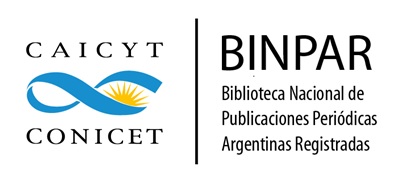University Youth: a Cyborg Sociality
DOI:
https://doi.org/10.24215/18524907e064Keywords:
university youth, cyborg, sociality, subjectivityAbstract
The emergence of youth, their sociality and subjective construction are addressed in this article from a theoretical discussion that seeks to unveil the cyborg proposal ontologically and epistemologically, the relationship of a horizontal agency, understanding its process guided by diversity and societal sentiment, be together. Starting to explore some experiences, it is suggested that artifacts express virtuality in the relationship between the cryptic and the expressive of the public, linking and building unknown spaces, making the hyperreality of relationships concrete whether they are offline or online in parallel.
Downloads
Metrics
References
Andrada Gregorio, G. y Sánchez Perera, P. (2016). Dispositivos, prótesis y artefactos de la subjetividad cíborg. Errancia, (14). Recuperado de
https://www.iztacala.unam.mx/errancia/v14/litorales_8.html
Baudrillard, J. (1978). Cultura y simulacro. Barcelona, España: Kairos.
Camarena, C. R. (2000). Los jóvenes y la educación. Situación actual y cambios intergeneracionales. Papeles de Población, 6(26), 26-41. Recuperado de http://www.redalyc.org/pdf/112/11202602.pdf
Cuadros Contreras, R. (2010). Ontología y epistemología cyborg: representaciones emergentes del vínculo orgánico entre el hombre y la naturaleza. Revista CS, (6), 317-330. https://doi.org/10.18046/recs.i6.470
Cubillas Rodríguez, M., Abril Valdez, E., Domínguez Ibáñez, S., Román Pérez, R., Hernández Montaño, A. y Zapata Salazar, J. (2016).
Creencias sobre estereotipos de género de jóvenes universitarios del norte de México. Diversitas, 12(2), 217-230. Recuperado de https://revistas.usantotomas.edu.co/index.php/diversitas/article/view/3245
Feixa, C. (1999). De jóvenes, bandas y tribus. Antropología de la juventud. Barcelona, España: Ariel. Recuperado de http://www.lazoblanco.org/wpcontent/uploads/2013/08manual/adolescentes/0012.pdf
Foucault, M. (2001) [1975]. Vigilar y castigar. Ciudad de México, México: Siglo XXI.
Gómez Rodríguez, J. M. (2013). Los jóvenes y la globalización. Un enfoque desde el financiamiento a la seguridad social. Revista Latinoamericana de Derecho Social, (16), 31-49. Recuperado de https://revistas.juridicas.unam.mx/index.php/derechosocial/article/view/9703
Haraway, D. (1991). Simios, Cyborgs and Woman: The Reinvention of Nature. New York, United States: Routledge.
Hernández-Guerrero, M. T., Alberti-Manzanares, P., Pérez-Nasser, E., Pérez-Olvera, M. A., Olivera-Méndez, A. y Talavera-Magaña, D. (2014). Relaciones, género y sexualidad entre jóvenes rurales de salinas de Hidalgo, San Luis Potosí, México. Ra Ximhai, 10(7), 197-212. Recuperado
de http://revistas.unam.mx/index.php/rxm/article/view/71460
Leyva Cordero, O., Muñiz, C. y Flores Hernández, M. de los Á. (2016). La conformación de actitudes políticas de los jóvenes universitarios
en el contexto preelectoral 2015 en Nuevo León. Revista Mexicana de Opinión Pública, (21), 51-70.
https://doi.org/10.1016/J.RMOP.2015.10.001
Majid Ramadan, A. (2017). El Consejo Supremo de la Juventud en Argelia: un segundo juicio amenazado por el conflicto de afiliaciones e intereses. Revista Democrática Árabe. Recuperado de https://democraticac.de/?p=46583
Marx, K. (1974) [1888]. Tesis sobre Feuerbach. En K. Marx y F. Engels (1974) [1968], La ideología alemana (Trad. de Wenceslao Roces). Montevideo, Uruguay: Ediciones Pueblos Unidos. Recuperado de https://proletarios.org/books/Marx-Ideologia_alemana.pdf
Mendizábal Oses, L. (1968). La política de la juventud: determinación de su concepto. Revista de Estudios Políticos, 16(162), 121-140. Recuperado de https://dialnet.unirioja.es/descarga/articulo/2082781.pdf
Moreno Hernández, H. C. (2016a). Quieto, atento y obediente. Violencias simbólicas entre adultos y jóvenes en escuelas secundarias del D.F. Ciudad de México, México: Universidad Nacional Autónoma México, Secretaría de Educación Pública, Administración Federal de Servicios Educativos en el Distrito Federal.
Moreno Hernández, H. C. (2016b). Cuerpo y resistencia. Entre la carne y la razón. Iberofórum. Revista de Ciencias Sociales de la Universidad
Iberoamericana, 11(21), 89-124. Recuperado de http://www.redalyc.org/pdf/2110/211049494003.pdf
Moreno Hernández, H. y Sánchez González, M. E. (2012). Pandilla 18 y Mara Salvatrucha 13: violencia y desciudadanización. CUHSO. Cultura-Hombre-Sociedad, 22(2), 47-80. Recuperado de https://cuhso.cl/index.php/cuhso/article/view/212
Net-med, Y (2016). ف ي عـالم=ا وو سـائ ل و ال ش باب حول ا س ت ق صائ ية درا سة ن ســط ل ف .Recuperado de https://bit.ly/3p9O2Xi
Reguillo Cruz, R. (2000). Emergencia de culturas juveniles. Estrategias del desencanto. Ciudad de México, México: Norma. Recuperado de https://www.iberopuebla.mx/sites/default/files/bp/documents/emergencia_de_culturas_juveniles_estrategias_del_desencanto_0.pdf
Sánchez-Castañeda, A. (2014). Los jóvenes frente al empleo y el desempleo: la necesaria construcción de soluciones multidimensionales y multifactoriales. Revista Latinoamericana de Derecho Social, (19), 133-162. Recuperado de https://revistas.juridicas.unam.mx/index.php/derechosocial/article/view/9747
Suárez Zozaya, M. H. (2018). Génesis de la juventud de los estudiantes universitarios. Perfiles Educativos, 40(159), 177-191. Recuperado de
Additional Files
Published
How to Cite
Issue
Section
License
Copyright (c) 2021 Eduardo Hernández de la Rosa, Hugo Cesar Moreno Hernández

This work is licensed under a Creative Commons Attribution-NonCommercial-ShareAlike 4.0 International License.
The acceptance of an original by the journal implies the non-exclusive transfer of the patrimonial rights of the authors in favor of the publisher, who allows the reuse, after its edition (postprint), under a Creative Commons License Attribution-NonCommercial-ShareAlike 4.0 International.
According to these terms, the material can be shared (copy and redistribute in any medium or format) and adapted (remix, transform and create another work from the material), provided that a) the authorship and the original source of their publication (magazine and URL of the work) are cited, b) is not used for commercial purposes and c) the same terms of the license are maintained.
The assignment of non-exclusive rights implies that after postprint in Revista Argentina de Estudios de Juventud authors may publish their work in any language, media and format; in that case, it is requested that they signal that the material was originally published by this journal.
Assignment also entails the authors’ authorization for the work to be collected by SEDICI, the institutional repository of the Universidad Nacional de La Plata, and for it to be indexed in the databases that the publisher thinks appropriate for enhancing the visibility of the published work and its authors.
In addition, the journal encourages authors to submit their works to other institutional and thematic repositories after their publication in Revista Argentina de Estudios de Juventud, under the assumption that offering society unrestricted access to scientific and academic production contributes to a greater exchange in global knowledge.













.png)

























